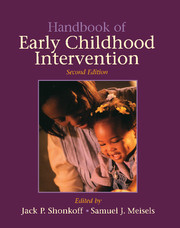Book contents
- Frontmatter
- Contents
- Foreword
- Preface
- Contributors
- PART ONE INTRODUCTION
- PART TWO CONCEPTS OF DEVELOPMENTAL VULNERABILITY AND RESILIENCE
- 2 The Biology of Developmental Vulnerability
- 3 Adaptive and Maladaptive Parenting: Perspectives on Risk and Protective Factors
- 4 The Human Ecology of Early Risk
- 5 Cultural Differences as Sources of Developmental Vulnerabilities and Resources
- 6 Protective Factors and Individual Resilience
- PART THREE THEORETICAL FRAMEWORKS FOR INTERVENTION
- PART FOUR APPROACHES TO ASSESSMENT
- PART FIVE SERVICE DELIVERY MODELS AND SYSTEMS
- PART SIX MEASURING THE IMPACT OF SERVICE DELIVERY
- PART SEVEN NEW DIRECTIONS FOR THE TWENTY-FIRST CENTURY
- Name Index
- Subject Index
4 - The Human Ecology of Early Risk
Published online by Cambridge University Press: 05 November 2011
- Frontmatter
- Contents
- Foreword
- Preface
- Contributors
- PART ONE INTRODUCTION
- PART TWO CONCEPTS OF DEVELOPMENTAL VULNERABILITY AND RESILIENCE
- 2 The Biology of Developmental Vulnerability
- 3 Adaptive and Maladaptive Parenting: Perspectives on Risk and Protective Factors
- 4 The Human Ecology of Early Risk
- 5 Cultural Differences as Sources of Developmental Vulnerabilities and Resources
- 6 Protective Factors and Individual Resilience
- PART THREE THEORETICAL FRAMEWORKS FOR INTERVENTION
- PART FOUR APPROACHES TO ASSESSMENT
- PART FIVE SERVICE DELIVERY MODELS AND SYSTEMS
- PART SIX MEASURING THE IMPACT OF SERVICE DELIVERY
- PART SEVEN NEW DIRECTIONS FOR THE TWENTY-FIRST CENTURY
- Name Index
- Subject Index
Summary
An ecological perspective on developmental risk directs our attention simultaneously to two kinds of interactions. The first is the interaction of the child as a biological organism with the immediate social environment as a set of processes, events, and relationships. The second is the interplay of social systems in the child's social environment. This dual mandate to look both outward to the forces that shape social contexts and inward to the day-to-day interaction of the child in the family is both the beauty and the challenge of human ecology. It demands much of us intellectually and ideologically, if it is to be more than an academic exercise.
Ecology is the study of relationships between organisms and environments. Ecologists explore and document how the individual and the habitat shape the development of each other. Like the biologist who learns about an animal by studying its habitat, sources of food, predators, and social practices, the student of human development must address how people live and grow in their social environment. Whereas all students of animal ecology must understand the purposeful actions of the organism, the human ecologist must go further and seek to incorporate the phenomenological complexity of the organism–environment interaction – the social and psychological maps that define human meaning.
We must recognize that the habitat of the child at risk includes family, friends, neighborhood, church, and school, as well as less immediate forces that constitute the social geography and climate (e.g., laws, institutions, and values) and the physical environment.
- Type
- Chapter
- Information
- Handbook of Early Childhood Intervention , pp. 76 - 93Publisher: Cambridge University PressPrint publication year: 2000
- 46
- Cited by

